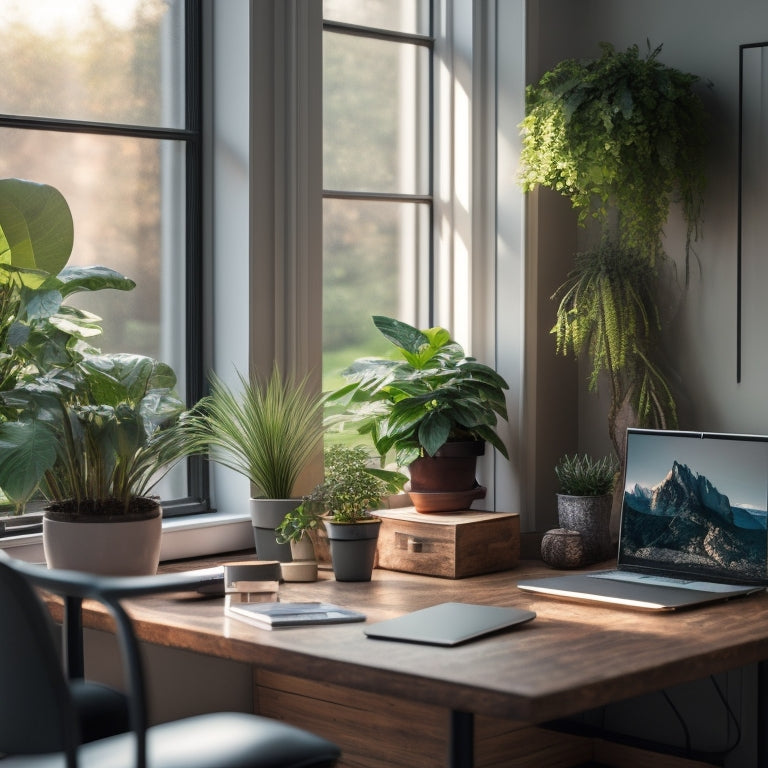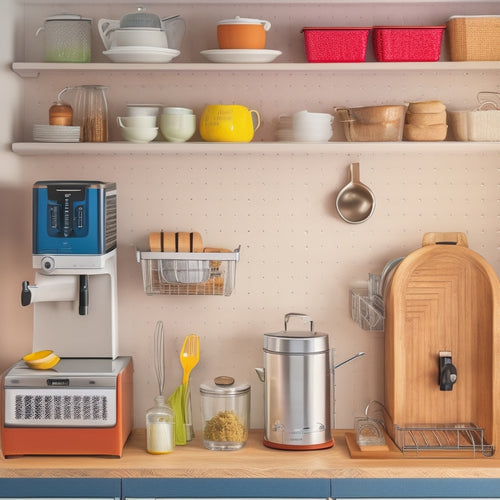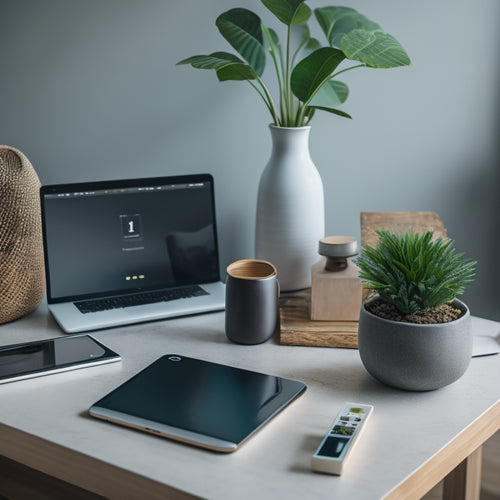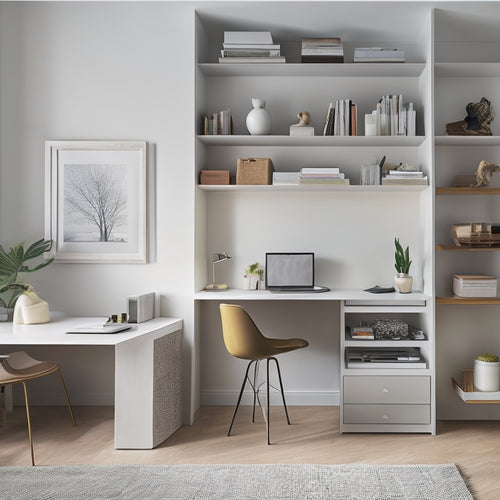
7 Best Ways to Boost Productivity at Home
Share
To boost productivity at home, start by decluttering your workspace and organizing essential items. Create a peaceful environment with soothing colors, calm sounds, and minimal distractions. Prioritize tasks with ease by setting clear objectives, categorizing tasks, and breaking them down into smaller chunks. Minimize digital distractions by setting phone-free zones and scheduling digital checks. Establish a morning routine to gain control and accomplish more. Use time-blocking to maximize efficiency and stay focused with regular breaks. By implementing these strategies, you'll be well on your way to achieving your goals - and there's even more to explore to take your productivity to the next level.
Key Takeaways
• Create a dedicated workspace with essential items only, and assign a designated spot for each item to maintain organization and focus.
• Minimize distractions by incorporating soothing colors, tranquil sounds, and considering white noise machines or apps to block out background noise.
• Prioritize tasks by categorizing them into must-haves, should-haves, and nice-to-haves, and break down large tasks into smaller, manageable chunks.
• Establish productive habits by waking up earlier, developing a consistent morning routine, and setting daily goals aligned with priorities.
• Utilize technology to boost productivity by using productivity apps, setting reminders, and automating repetitive tasks to save time and effort.
Declutter Your Workspace Now
You probably spend a significant amount of time searching for misplaced papers, lost notes, or that one specific pen, which is a huge productivity killer. This cluttered workspace not only wastes your time but also affects your focus and mental clarity.
It's time to declutter your workspace and get organized!
Start by categorizing your desk items into essential and non-essential groups. Get rid of anything unnecessary, and assign a designated spot for each essential item. Invest in desk organization tools like trays, baskets, or drawers to keep frequently used items within easy reach.
Implementing storage hacks can also help you stay organized. Use adhesive hooks to hang cables, bags, or other items, and label your storage containers to make sure you can find what you need quickly. Consider a desk organizer with built-in compartments or a cordless charging pad to keep your workspace tidy.
Create a Peaceful Environment
Establishing a peaceful environment is essential for maintaining focus and productivity while working from home, as it helps to minimize distractions and promote mental clarity. When you create a peaceful space, you'll find it easier to stay focused and motivated.
One way to achieve this is by incorporating soothing colors into your workspace. Research has shown that certain colors can have a significant impact on our mood and productivity. Here are some examples:
| Color | Effect | Recommended Use |
|---|---|---|
| Light Blue | Calming, relaxing | Walls, furniture, or accents |
| Green | Balancing, invigorating | Plants, wall art, or rugs |
| Yellow | Uplifting, energizing | Accessories, lighting, or decorative items |
| Neutral | Soothing, calming | Background colors, furniture, or upholstery |
In addition to soothing colors, tranquil sounds can also help create a peaceful environment. Consider playing calming music or nature sounds in the background while you work. You can also use white noise machines or apps to block out distracting sounds. By incorporating these elements, you'll be able to create a space that promotes focus, productivity, and mental clarity.
Prioritize Tasks With Ease
To prioritize tasks with ease, you'll need to get crystal clear on what needs to be done and how to manage your tasks effectively.
By setting clear objectives, you'll be able to focus on what's truly important and avoid wasting time on non-essential tasks.
Set Clear Objectives
By setting clear objectives, daily tasks fall into place, allowing you to tackle the most critical ones first and make the most of your time. This is where goal mapping and vision boarding come in – two powerful tools to help you clarify your objectives.
| Goal | Why | How |
|---|---|---|
| Increase productivity | To have more free time | Create a schedule and prioritize tasks |
| Improve work-life balance | To reduce stress | Set boundaries between work and personal life |
| Learn a new skill | To enhance career prospects | Allocate dedicated time for learning |
| Reduce procrastination | To achieve tasks efficiently | Break tasks into smaller, manageable chunks |
| Enhance creativity | To think outside the box | Set aside time for brainstorming and idea generation |
Task Management Essentials
Sort your tasks into must-haves, should-haves, and nice-to-haves to prioritize them with ease. This simple categorization helps you focus on the most critical tasks first, ensuring you make progress on your essential objectives.
Next, break down large tasks into smaller, manageable chunks, making them less overwhelming and more achievable.
When it comes to task delegation, identify tasks that can be handled by others, such as family members or freelancers. By delegating tasks, you free up time and energy for high-priority tasks that require your attention.
Additionally, use calendar syncing to schedule tasks and set reminders, ensuring you stay on track and meet deadlines. This integration also helps you avoid overcommitting and allows for better time management.
Minimize Digital Distractions
You're likely guilty of checking your phone every few minutes, but constant digital distractions can derail your entire day. It's crucial to establish phone etiquette and set screen limits to minimize digital distractions.
When you're working from home, it's easy to get sidetracked by social media, emails, or text messages. However, these distractions can greatly reduce your productivity.
To avoid digital distractions, try the following:
-
Set specific times to check your phone or computer for messages or updates
-
Use website blockers or apps that track and limit your screen time
-
Designate a 'phone-free' zone in your home, such as your workspace or dining area
- Schedule breaks to check your phone or computer, and stick to those times
Establish a Morning Routine
When you establish a morning routine, you're setting yourself up for a productive day. By waking up earlier, you'll have time to reflect on what needs to be done and prioritize your tasks.
Wake Up Earlier
By rising with the sun, you can get a head start on your day, giving yourself a sense of control and accomplishment before the chaos begins. Waking up earlier can be challenging, but it's worth the effort.
One of the biggest Consistency Challenges people face is developing a consistent morning routine. However, by doing so, you can train your brain to adopt a Morning Mindset, focused on tackling the day ahead.
Here are some benefits of waking up earlier:
-
Increased productivity: Get a head start on your tasks and achieve more before the day gets busy.
-
Improved mental clarity: Waking up earlier gives you time to meditate, reflect, or simply enjoy a quiet cup of coffee, helping you feel more centered and focused.
-
Enhanced creativity: The morning hours can be a great time for brainstorming and idea generation, when your mind is fresh and uncluttered.
- Better time management: By rising earlier, you can prioritize your tasks and make the most of your time, setting yourself up for success.
Set Daily Goals
With your morning mindset established, take the next step by setting daily goals that align with your priorities, helping you stay focused and motivated throughout the day.
You'll be more productive when you know exactly what you need to accomplish. Start by identifying your top three tasks that require attention. Break them down into smaller, manageable chunks, and prioritize them based on importance and urgency.
Write down your goals and track your progress throughout the day. This will help you stay on track and make adjustments as needed. Be flexible, though – life can be unpredictable, and priorities may shift. Don't be too hard on yourself if you need to adjust your goals mid-day. Instead, focus on making progress and celebrate your accomplishments.
Effective goal tracking will help you identify patterns and areas for improvement, allowing you to optimize your daily routine for maximum productivity.
Use Time-Blocking Effectively
You'll be amazed at how much you can accomplish when you divide your day into focused, uninterrupted blocks of time dedicated to specific tasks. This technique is called time-blocking, and it's a powerful tool for boosting productivity at home. By scheduling specific tasks into fixed time slots, you can create a sense of structure and control over your day.
Here are some tips to help you use time-blocking effectively:
-
Set clear personal boundaries: Identify the tasks that require your undivided attention and schedule them accordingly. Learn to say no to distractions and interruptions during these blocks.
-
Make accurate time estimates: Be realistic about how long each task will take. Don't underestimate or overestimate the time needed, as this can lead to frustration and burnout.
-
Group similar tasks together: Batch similar tasks, such as checking emails or making phone calls, to maximize your efficiency.
- Leave some buffer time: Don't overschedule yourself. Leave some buffer time between tasks to account for unexpected interruptions or tasks that take longer than expected.
Stay Focused With Breaks
Taking regular breaks can actually help you stay focused and refreshed, allowing you to tackle tasks with renewed energy and attention. It might seem counterintuitive, but breaks can help you stay on track and avoid burnout.
When you work continuously without stopping, your brain can become fatigued, leading to decreased productivity and increased mistakes. By taking short breaks, you can give your brain a mental refreshment, allowing it to recharge and refocus.
Use your breaks to do something enjoyable, like taking a short walk or meditating. This energy recharge will help you come back to your task with renewed enthusiasm and a clear mind.
Try setting a timer to take a 10-15 minute break every hour to stay focused and refreshed. Remember, taking breaks isn't a waste of time, but rather an investment in your productivity and overall well-being.
Frequently Asked Questions
How Do I Avoid Procrastination When Working From Home?
To avoid procrastination when working from home, you're setting yourself up for success by creating a schedule with time blocking and specific goal setting, allowing you to stay focused and motivated throughout the day.
Can I Be Productive in a Small or Cluttered Living Space?
You can conquer clutter by crafting a clever space planning strategy, creating calm zones, and curating a declutter routine that lets you focus on what matters, making productivity possible even in small spaces.
What if I'm a Night Owl and Not a Morning Person?
You're a night owl, and your circadian rhythm is naturally set to later hours. Don't fight it; instead, adjust your sleep schedule to suit your needs, and you'll find your productivity soaring, even in the wee hours.
How Do I Handle Distractions From Family Members or Roommates?
You set boundaries with family members or roommates by communicating your work hours and needs clearly, establishing a dedicated workspace, and using visual cues like a "do not disturb" sign to minimize interruptions.
Is It Necessary to Take Breaks, or Can I Work Long Hours?
'You're tempted to tackle tasks tirelessly, but trust us, taking breaks is essential. Failing to do so can lead to fatigue, fizzling out, and ultimately, burnout. Prioritize work-life balance to prevent exhaustion and maintain momentum.'
Related Posts
-

Smart Storage for Small Kitchen Appliances
You can optimize your small kitchen's functionality by implementing smart storage solutions that efficiently stash sm...
-

Top Digital Tools for Home Decor Organization
You're looking to take your home decor organization to the next level with the right digital tools. From cloud storag...
-

7 Essential Strategies for More Storage Space
Take back control of your space by implementing these 7 essential strategies for more storage space. Start by maximiz...


